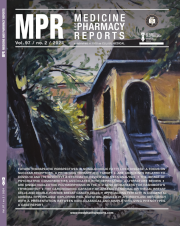Future therapeutic perspectives in nonalcoholic fatty liver disease: a focus on nuclear receptors, a promising therapeutic target
DOI:
https://doi.org/10.15386/mpr-2628Keywords:
non-alcoholic fatty liver disease, nuclear receptors, liver X receptor, treatmentAbstract
Non-alcoholic fatty liver disease (NAFLD) is a major public health problem worldwide, with an increasing incidence, secondary to the increasing incidence of obesity and diabetes, from a very young age. It is associated with metabolic and cardiovascular disorders, as components of the metabolic syndrome (MS). NAFLD is the hepatic manifestation of MS. The pathogenesis of the disease is multifactorial and complex, involving genetic, metabolic, but also environmental factors. Currently, nuclear receptors (NRs) represent a promising therapeutic target in the treatment of non-alcoholic steatohepatitis (NASH). Of these, the most studied receptor was the liver X receptor (LXR), which would have great potential in the treatment of metabolic diseases, namely hypercholesterolemia, atherosclerosis, and NAFLD. However, the therapeutic use of NRs is restricted in medical practice for two reasons: limited knowledge of the structure of the receptor and its inability to modulate certain actions in the target organs and genes. One problem is the understanding of the function and structure of the N-terminal domain which has a major transcriptional activation function (AF1).
Downloads
Published
How to Cite
Issue
Section
License
The authors are required to transfer the copyright of the published paper to the journal. This is done by agreeing to sign the Copyright Assignment Form. Whenever the case, authors are also required to send permissions to reproduce material (such as illustrations) from the copyright holder.

The papers published in the journal are licensed under a Creative Commons Attribution-NonCommercial-NoDerivatives 4.0 International License.

